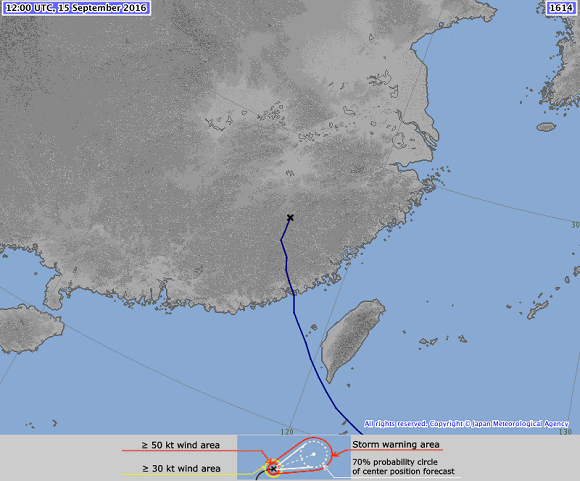Typhoon Meranti
Status: Closed
| Type of posting | Posting date(EST): | Summary | Downloads |
|---|---|---|---|
| Post Landfall 1 | 9/29/2016 5:30:00 AM |
|
|
| Landfall | 9/15/2016 9:00:00 AM |
|
|
| Pre-Landfall 2 | 9/14/2016 2:00:00 PM |
|
|
| Pre-Landfall 1 | 9/12/2016 10:00:00 AM |
|
Landfall | Summary
Posting Date: September 15, 2016, 9:00:00 AM
Having passed south of Taiwan on September 14, Typhoon Meranti made landfall at 3.05 a.m. local time on Thursday, September 15, in the Xiang'an district of Xiamen City, in east China's Fujian Province. Following its interaction with Taiwan, Meranti weakened significantly as it approached China and it came ashore with a central pressure of 940 mb, the equivalent of a Category 4 hurricane—the strongest typhoon in the region since 1949.
Fujian is one of the Chinese provinces most often affected by typhoons, but exposures in the province are somewhat protected by Taiwan, which lies directly to the east across the Taiwan Strait. Although storms that interact with the mountainous terrain of Taiwan may regain typhoon status before making landfall on China’s mainland coast, they are typically weakened. Even these weakened storms, however, can bring heavy rainfall and significant flooding, which can contribute more to insured losses than typhoon winds. The region experiences 10 times as many weak typhoons as strong ones. Meranti is expected to weaken further as it moves inland and turns towards Shanghai, but it is still capable of delivering dangerous winds and heavy precipitation for another 48 hours.
Track map for Meranti at 12:00 UTC, September 15. (Source: JMA)
Reported Impacts
In advance of the typhoon, the China Meteorological Administration issued its highest alert warning and the National Marine Environmental Forecasting Center upgraded its warning for ocean waves to "red." Fishing boats were recalled and ferry services suspended. Many flights and train services were also canceled. Schools and kindergartens in coastal cities closed and tens of thousands of people were evacuated, disrupting the three-day Mid-Autumn Festival holiday.
As well as strong and damaging winds, Meranti is producing prodigious precipitation. The cities of Xiamen and Quanzhou are experiencing widespread power outages, flooding, disrupted water supplies, and fallen trees. Windows on some tall buildings reportedly shattered. A Song dynasty wooden bridge has been washed away in Yongchun County, and three historic bridges, similarly about 800 years old, have been damaged in Quanzhou. Fuzhou, the capital of Fujian, is experiencing particularly severe flooding. Mudslides are likely across the region.
Exposure at Risk
Fujian is often described as "eight parts mountain, one part water, and one part farmland." The economy of coastal Fujian, however, benefits greatly from its proximity to Taiwan, and because of its industry and the presence of many foreign firms, Fujian is one of China’s more affluent provinces.
Most urban dwellers live in mid-rise or high-rise apartment buildings, many of which have commercial establishments on the ground floor. Mid-rise buildings are often confined masonry, while high-rises tend to be reinforced concrete. China has a diverse commercial/industrial building stock, which is generally more resistant to wind and water damage than residential buildings. Historically, the dominant construction types in China are unreinforced masonry made from adobe or brick, or brick with a light wood frame. These construction types are still ubiquitous throughout rural China.
Three similar stochastic event (SSE) IDs for events similar to Meranti are now available for download.
The AIR tropical cyclone team will continue to monitor Typhoon Meranti.